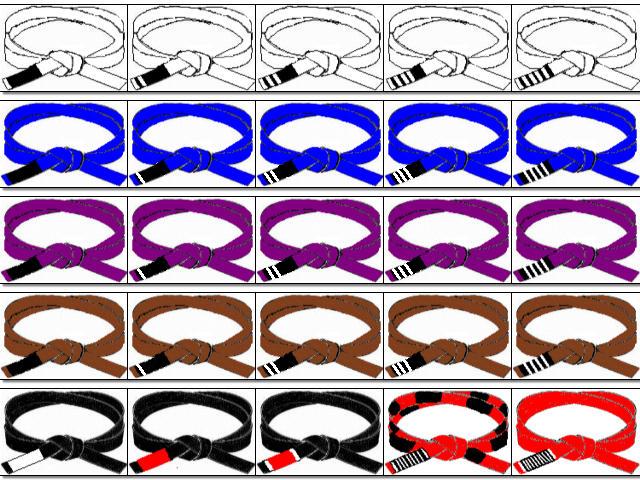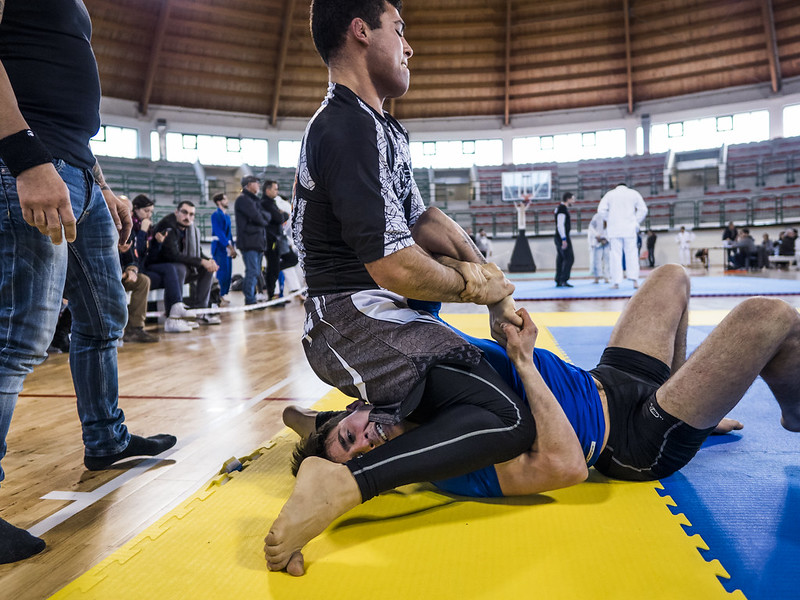Earning a new Jiu-Jitsu belt feels like finding a secret box of treasures. Every belt color tells its own story, showing what a student can do and shining a light on their Jiu-Jitsu adventure.
The colourful belts did not always denote rank or progression. The belt levels did not even exist until 1907. Belts were introduced to the martial arts as recently as 1907. The belts or Obi were introduced along with the Gi to martial arts. The BJJ Gi remains an incredibly important part of the sport.
Table of Contents
History Of Belts
However, even when belts were initially introduced, they did not hold the significance they do today. They were either black or white. Later, in 1926, at the 9th Annual Budokwai Display, the first round of colored belts was debuted.
After their initial debut, the belts only took a few more years to be established in the UK and France. However, the Jiu-Jitsu belt levels signified ranks as student, instructor, and master.
There were only three colours – white for students, light blue for instructors, and dark blue for masters.
The system in place today was largely a combined effort of the Sport Jiu-Jitsu International Federation and the International Brazilian Jiu-Jitsu. They implemented not only the different colors but also the ranking and progression of students.
With this new system in place, it wasn't long before the different colours and their respective ranks needed to be brought into Brazilian Jiu-Jitsu.

Belt Level Types
The belt ranks are split into two distinct categories. Since there are separate modes of instruction for children and adults, the Brazilian belt order is split similarly. There is a different set of belts for adults and children.
Adult Belt Levels
Adult BJJ belt ranks start after the age of 16 in most cases. There are five main belt colours in Brazilian Jiu-Jitsu, followed by two Coral Belts and one final belt. Read on to find out what every single one of them denotes.
White Belt
The white belt is the first belt that every student starts with. Whatever the age, a student can start with a white belt. At this stage, any student should be focusing on the fundamentals such as:
- Posturing in closed guard
- Opening and closing the guard
- Three sweeps from the bottom
- Essential submissions from closed-guard
- Escapes
Apart from the fundamentals, any white belt should master three escape techniques:
- Escape from low-mount
- Escape from side control
- Escape from back control
While there isn't a minimum period you must stay at the white belt, it is best to focus on drilling and perfecting the fundamentals.
Blue Belt
The minimum age required to be a blue belt is 16. Most students find themselves at the blue belt when transitioning to adult belt levels. The blue belt is earned based on merit and is the longest you'll spend at a belt level on the way to a black belt.
This level requires a minimum of 2 years of training before you can move up to a purple belt. Using Jiu-Jitsu techniques, you'll be able to defend yourself against someone bigger and stronger.
Ideally, a blue belt should be well-versed in the following skills:
- Being as effective on top as the bottom
- Be able to escape from someone with similar training experience
- Be able to finish opponents
- Have a working knowledge of elbow escapes, hook sweeps, knee slices, guard passes, and back strangles.
Purple Belt
The purple belt is difficult to earn, taking up to 5 years. A student needs to be at least 16 years old for a purple belt. Unlike the blue belt, athletes must spend at least 1.5 years in this jiu-jitsu belt.
This stage is also when mentoring starts, along with the refinement of technique. A purple belt is expected to be proficient at every basic technique and refine your skill set. At this stage, you will expect to:
- Control and submit any blue belts
- Won't struggle against a blue belt
- Are a challenge for brown belts
- Know the details of combinations and complicated positions
Brown Belt
As the belt right before the black belt, you will be expected to know how to dominate, control, and submit any purple belts, even if they put up a fight. At this belt, athletes are usually 18 and must spend just a year refining their technique and skill set. You're honing your skills and combining the tools and techniques you've learned.
Black Belt
A student must be at least 19 to obtain a black belt. After obtaining this illustrious belt, an athlete must complete at least 31 years before moving to a coral belt.
There are requirements to earn a black belt that goes beyond age:
- First aid and CPR course certificate
- IBJJF affiliation
- Over 60% in the IBJJF Referee Course
- Either the head or assistant instructor at an IBJJF-affiliated gym
- Or must practice at a gym with an IBJJF affiliation
- An IBJJF-affiliated 2nd-degree black belt instructor needs to promote the athlete.
A black belt is hard to earn, taking 8-12 years of training. It isn't just about meeting the requirements but knowing skills such as:
- High level of proficiency in core techniques
- Effective attacks across the body
- Should be able to dominate and control brown belts
- Are proficient in self-defense
Coral Belts
Coral belts are an incredible honor and require 30 years as a black belt. These belts are the highest of the Jiu-Jitsu belt ranks. You'll find two coral belts being awarded:
- Red and Black
An athlete needs to be at least 50 to hold this coral belt. It represents a 7th-degree black belt and needs to be held for at least 7 years before one can progress.
- Red and White
An athlete is eligible for a red and white coral belt at the age of 57. This coral belt counts as an 8th-degree black belt and must be held for a minimum of 10 years.
Red Belt
Eligibility for a red belt begins at the age of 67. This is the highest level of mastery one can reach, equivalent to a 9th—and 10th-degree grandmaster belt. The red belt, with its gold and white stripes, is the highest honor in BJJ belts.
Youth Belt Ranks

Youth belt ranks start at age 4 and go up to age 15. These BJJ belts are the precursor to the adult blue belt, which they can receive only at age 16. The International Brazilian Jiu-Jitsu Federation set out 13 belts for competitors under the age of 12.
They go as follows:
- 4 to 15 years – White, grey-white, grey, and grey-black belts.
- 7 to 15 years – Yellow-white, yellow, and yellow, black belts.
- 10 to 15 years – Orange-white, orange, and orange-black belts.
- 13 to 15 years – Green-white, greed, and green-black.
Once the student has turned 16, they are transitioned to the adult belt system, depending on their progress. If they are at a white belt, then they will remain at a white belt. Students who have progressed to a grey, yellow, or orange belt can be awarded either a white or blue belt, depending on the professor's decision. Any student awarded a green belt can transition to a white, blue, or purple belt, depending on the professor's discretion.
Promotion
Going up the Jiu-Jitsu belt order isn't easy. It takes dedication and drilling to get to every level. Apart from hard work, reaching higher belt ranks depends on the technical and conceptual knowledge a competitor can exhibit in the academy and competitions.
Formal Testing
While Brazilian Jiu-Jitsu generally takes an informal promotion approach, most academies have a more formal and systematic testing method. These formal tests depend mainly on the student's academy; however, they all have similar elements.
Formal testing requires students to exhibit technical and conceptual knowledge and apply their skills against opponents. Generally, these formal tests require payment of testing fees and some pre-testing private lessons.
Competitions
Another aspect of promotions is competition. Students are regularly encouraged to compete throughout their journey in Brazilian jiu-jitsu. Competitions help them develop experience and allow instructors to gauge students' abilities.
If there has been a good competition performance, a promotion generally goes along with it. While it isn't usually mandatory to compete, some schools make it a requirement to participate.
Endnotes
BJJ belts signify an athlete's progress and dedication to the sport. With each new belt they are awarded, an athlete gets closer to the title of master, to the mastery of a sport they've dedicated their lives to. However, it is no easy feat.
Despite the difficulty, many athletes have put in a lifetime's worth of work to get to the common goal of achieving a black belt. All that is left to say is good luck to the athletes as they progress through the BJJ belt levels!
Frequently Asked Questions About BJJ Belt Ranks
What are stripe degrees?
Some academies generally award stripe degrees as a form of recognition between belts. Students can receive several stripes within each belt to indicate their skill level for particular belt ranks.
Who decides the promotions?
Generally, the academy or instructors deal with promotions or awarding of stripes. They are the best judges of a student's ability after seeing their performance within the academy and at competitions.
Latest Posts:
- The Impact of Professional Brand Image on BJJ Athletes
- The Ultimate Guide to Traveling with Your BJJ Gear: Tips and Tricks for Keeping Your Equipment Safe and Secure
- The Connection Between Quality Custom Leisurewear and BJJ Success
- The 7 Best Compression Shorts for NO-GI BJJ of 2024
- 15 Best Grappling Shorts for BJJ and MMA in 2024- Review
I'm Andrew, the entrepreneurial mind behind AV SEO Consultant Boutique Agency, with a deep-rooted love for cats and a knack for crafting the perfect home office. As the co-founder of Brazilian Jiu-Jitsu World, my expertise has evolved from the mat to the digital realm, where I now leverage my SEO savvy to empower others. Though injury may have paused my BJJ and MMA journey, my commitment to sharing actionable insights and resources for these passions remains unshaken.





